Computation of the Domain of Attraction for Suboptimal Immunity Epidemic Models Using the Maximal Lyapunov Function Method
Abstract
We are concerned with the estimation of the domain of attraction (DOA) for suboptimal immunity epidemic models. We establish a procedure to determine the maximal Lyapunov function in the form of rational functions. Based on the definition of DOA and the maximal Lyapunov function, a theorem and subsequently a numerical procedure are established to determine the maximal Lyapunov function and the DOA. Determination of the domain of attraction for epidemic models is very important for understanding the dynamic behaviour of the disease transmission as a function of the state of population distribution in different categories of disease states. We focus on suboptimal immunity epidemic models with saturated treatment rate and nonlinear incidence rate. Different from classical models, suboptimal immunity models are more realistic to explain the microparasite infection diseases such as Pertussis and Influenza A. We show that, for certain values of the parameter, larger k value (i.e., the model is more toward the SIR model) leads to a smaller DOA.
1. Introduction
The computing of domain of attraction (DOA), that is, the region where the dynamical system is asymptotically stable, is an interesting research topic in the stability analysis of nonlinear systems such as the systems for compartmental ODE epidemic models. In other words, the mathematical analysis of epidemic models often involves computing the asymptotic stability region for both the disease-free equilibrium and endemic equilibrium. The set of initial states whose corresponding trajectories converge to an asymptotically stable equilibrium point as time increases is known as the stability region or domain of attraction (DOA) of the equilibrium under study. If the initial state lies within the DOA, the disease will evolve towards an endemic state. On the contrary, if the initial state is outside the DOA, the system will converge to a disease-free state. Therefore, it is important to study the DOA of endemic equilibrium.
Lyapunov’s second method (the direct method) is generally used to analyze the stability of epidemic models. In this method, the asymptotic stability of the origin can be examined if a positive definite function whose derivative along the solutions of the system is negative definite. However, it is not only difficult to construct the Lyapunov Function, but also hard to guarantee the asymptotical stability of the equilibrium. Apart from that, it is known even if the Lyapunov function exists in an autonomous ODE, it may not be unique. A maximal Lyapunov function is a special Lyapunov function on S (where S denotes the DOA) which can be used to determine the DOA for a given locally asymptotical stable equilibrium point.
Considerable work on DOA estimation and optimized DOA for epidemic dynamical models has been done. In [1], the authors had computed the DOA in epidemiological models with constant removal rates of infected individuals. An optimization approach for finding the DOA of a class of SEIR models, based on the sum of square optimization, is presented in [2]. Recently, the authors in [3] had adopted a recurrence formula established by Kaslik et al. [4] by using an R-analytical function and the sequence of its Taylor polynomial to construct the Lyapunov function, and solved the linear matrix inequality (LMI) relaxations of a global optimization problem to obtain the DOA. However, all the epidemic models in the papers mentioned above are limited to relatively simple epidemic models, without taking into account nonlinear incidence rates or saturated recovery rates. In this paper, we study the DOA for the suboptimal immunity models with nonlinear incidence rates and saturated recovery rates, by utilizing the maximal Lyapunov function in [5]. Throughout the paper, we focus on DOA for the suboptimal immunity models. This kind of suboptimal immunity models is more appropriate for the study of microparasite infections which usually occurs during childhood. After a primary infection, one may get temporary immunity (namrly, immune protection that will wane over time) or partial immunity (namrly, immunity that is not fully protective). Examples of this kind of diseases include Pertussis (temporary immunity) and Influenza (partial immunity).
The rest of the paper is organized as follows. In Section 2, we will establish a theorem based on [5] and an iterative procedure for the construction of the Maximal Lyapunov Function. In Section 3, we will briefly explain the suboptimal immunity model. In Section 4, two examples of suboptimal immunity models are given to demonstrate the validity of the procedure. A conclusion is then given in Section 5.
2. Maximal Lyapunov Function
- (a)
f(0) = 0, that is, x = 0 is an equilibrium point of system (1);
- (b)
all the eigenvalues of the Jacobian matrix at x = 0, that is, (∂f/∂x)(0), have negative real parts, namely, x = 0 is an asymptotically stable equilibrium point.
It is well known that in the Lyapunov sense, if there exists a Lyapunov function for the equilibrium point x = 0 of the system (1), then x = 0 is asymptotically stable.
Definition 1 (Lyapunov function). Let V(x) be a continuously differentiable real-valued function defined on a domain R(0)⊆ℝn containing the equilibrium point x = 0. The function V(x) is a Lyapunov function of the equilibrium x = 0 of the system (1) if the following conditions hold:
- (a)
V(x) is positive definite on R(0);
- (b)
the time derivative of is negative definite on R(0).
If V(x) is a Lyapunov function which fulfills the conditions in the Definition 1, the estimation of DOA is given by the following definition.
Definition 2. Given an autonomous system (1), where x ∈ ℝn and f(0) = 0, the domain of attraction (DOA) of x = 0 is SA = {x0 ∈ ℝn : lim t→∞x(t, x0) = 0}, where x(·, x0) denotes the solution of the autonomous system corresponding to the initial condition x(0) = x0.
The Lyapunov function is not unique. A maximal Lyapunov function, V(x), is a special Lyapunov function on S (where S denotes the DOA) which can be used to determine the DOA for a given locally asymptotically stable equilibrium point.
Definition 3 (maximal Lyapunov function [5]). A function Vm(x) : ℝn → ℝ+ ∪ {∞} is called a maximal Lyapunov function for the system (1) if
- (a)
Vm(0) = 0, Vm(x) > 0, for all x ∈ S, x ≠ 0;
- (b)
Vm(x) < ∞ if and only if x ∈ S;
- (c)
Vm(x) → ∞ as x → ∂S and/or ∥x∥→∞;
- (d)
is well defined and negative definite over S, where S denotes the DOA.
We have the following definition for the DOA of an asymptotically stable equilibrium point which derives from the maximal Lyapunov function.
Definition 4. Suppose we can find a set E⊆ℝn containing the origin in its interior and a continuous function V(x) : E → ℝ+ such that
- (a)
V(x) is positive definite on E;
- (b)
is negative definite on E;
- (c)
V(x) → ∞ as x → ∂S and/or as ∥x∥→∞. Then E = S, where S denotes the DOA.
From the above definition, based on the work in [5], we derive the following theorem.
Theorem 5. Consider the nonlinear system of equations , where Fi(·) is a homogeneous function of degree i. Suppose that the linearized system is asymptotically stable at x = 0. Let Ri, Qi be homogeneous functions of degree i, and the functions Ri and Qi satisfy the following recursive equations:
Proof. Rewrite
Based on Theorem 5, the procedure for obtaining the maximal Lyapunov function and calculating the DOA is established as follows.
Step 1. From the linearized system, F1 = Ax, find P > 0 such that ATP + PA = −Q, then set
Step 2. For n = 3, we have
Step 3. For n = 4, we have
Step 4 (optional). For n = 5, we have
For each of the Steps 2 and 4, one will lead to a number of choices for the value of the coefficients for Rn and Qn−2. Consider
Step 5. Once we get en(y) sufficiently small, say at Step 3, we can have the maximal Lyapunov function as
3. Suboptimal Immunity Epidemic Models
In this paper, we estimate the domain of attraction (DOA) for suboptimal immunity epidemic models with saturated treatment/recovery rate and nonlinear incidence rate. Apart from using the saturated treatment/recovery rate, an additional parameter σ is used to form the suboptimal immunity model as in [7]. The new model lies in between the SIS and SIR models.
4. Numerical Examples
Example 1. We consider the following reduced system for the suboptimal immunity model with bilinear incidence rate and saturated treatment rate:
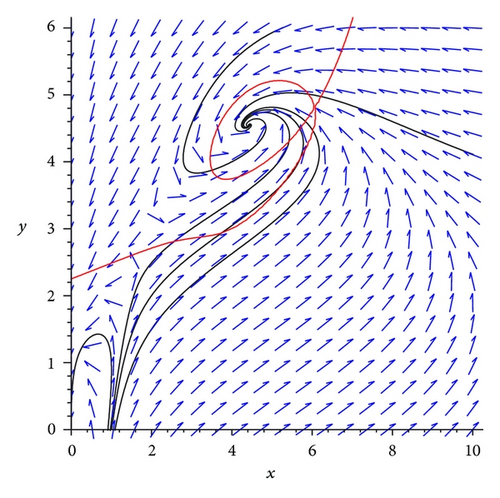
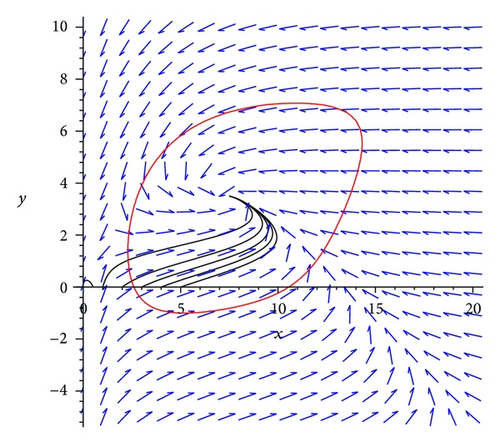
Example 2. We consider the following reduced system for the suboptimal immunity model with nonlinear incidence rate and saturated treatment rate:
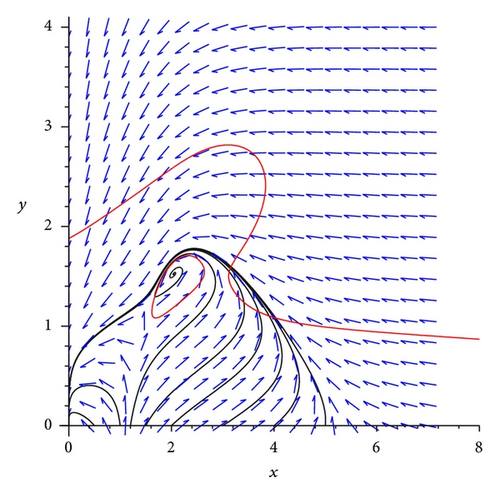
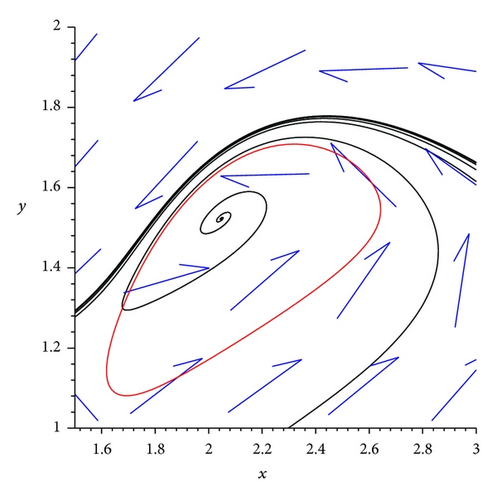
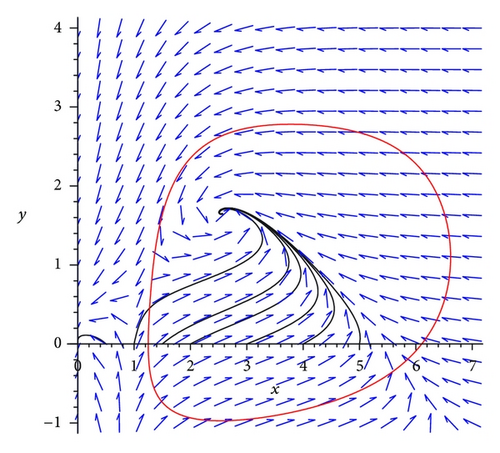
By applying the same procedure, we calculate the DOA when a = 12, and we obtain the DOA as in Figure 5. It is clear that with (A, β, v, c, a, μ, k) = (6,0.5,1.27,2, 12,1, 0.5), increasing the value of a will increase the DOA for the suboptimal model given by (20).
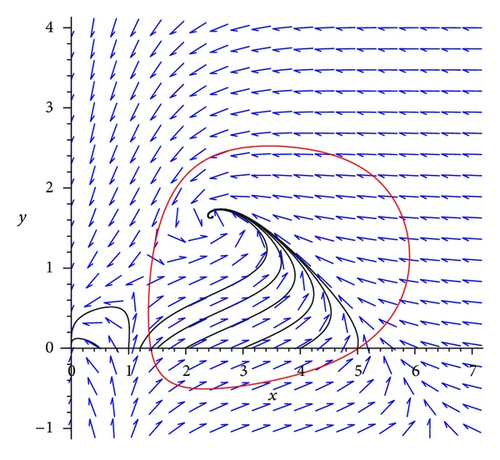
5. Concluding Remarks
In this paper, we deal with the problem of estimating the domain of attraction (DOA) for the suboptimal epidemic model. We have successfully established a procedure to determine the maximal Lyapunov function in the form of rational functions and compute the domain of attraction for epidemic models. Determination of the DOA is extremely important in order to understand the dynamic behaviour of the transmission of disease as a function of the initial population distribution. In our first example, we show that, for certain values of the parameter, a larger k value (i.e., the model is more toward the SIR model) leads to a smaller DOA. In our second example, we show that within certain values of the parameter, decreasing the a value will yield a smaller DOA.
Acknowledgments
The authors are grateful to the anonymous reviewers for their helpful suggestions and comments. The third author wishes to acknowledge the support of the Faculty of Science, Mahidol University.




